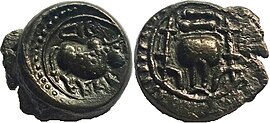Our website is made possible by displaying online advertisements to our visitors.
Please consider supporting us by disabling your ad blocker.
Vishnukundina dynasty
This article includes a list of general references, but it lacks sufficient corresponding inline citations. (March 2016) |
Vishnukundina dynasty | |||||||||||
|---|---|---|---|---|---|---|---|---|---|---|---|
| 420–624 | |||||||||||
Vishnukundina Empire, 420–674 AD, cast copper, 4.65g, Vidarbha (Maharashtra), Bull type. | |||||||||||
The Vishnukundinas and neighbouring South Asian polities c. 500 CE.[1] | |||||||||||
| Capital | Denduluru Amaravati | ||||||||||
| Common languages | Sanskrit Prakrit | ||||||||||
| Religion | Hinduism Jainism | ||||||||||
| Government | Monarchy | ||||||||||
| Janasraya | |||||||||||
| Historical era | Classical India | ||||||||||
• Established | 420 | ||||||||||
• Disestablished | 624 | ||||||||||
| |||||||||||
The Vishnukundina dynasty (IAST: Viṣṇukuṇḍina, sometimes Viṣukuṇḍin) was an Indian dynasty that ruled over parts of present-day Andhra Pradesh, Telangana, Odisha, and other parts of southern India between the 5th and 7th centuries. They emerged as an independent power during the reign of Madhava Varma, who conquered coastal Andhra from the Salankayanas and established their capital at Denduluru near Eluru. Their rule significantly shaped the history of the Deccan region. However, their reign ended with the conquest of eastern Deccan by the Chalukya king Pulakeshin II, who appointed his brother, Kubja Vishnuvardhana, as viceroy. Vishnuvardhana later declared independence, founding the Eastern Chalukya dynasty.
- ^ Schwartzberg, Joseph E. (1978). A Historical atlas of South Asia. Chicago: University of Chicago Press. p. 26,146. ISBN 0226742210.
Previous Page Next Page





